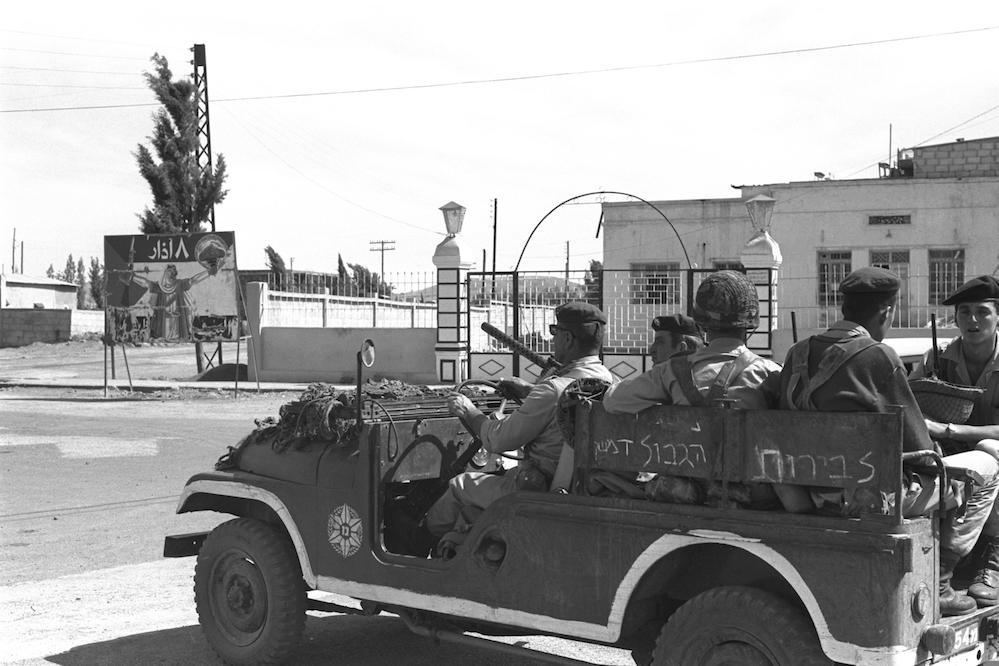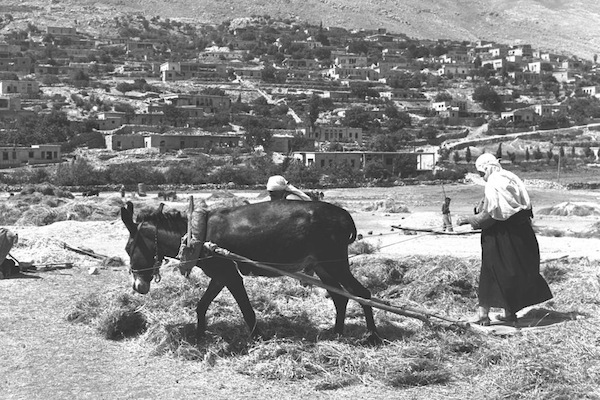As opposed to Palestinian refugees, the fate of the Syrians expelled from the Golan Heights by Israel in 1967 was covered up and hidden from public awareness. Even today, most Israelis believe the area was largely empty of Syrians, and anyone who may have been there fled voluntarily.
By Irit Gal

Among the Syrian refugees fleeing their burning country to the European countries that were kind enough to open their gates, there are those who belong to a second generation of refugees. The first fled in 1967 when the Syrian Golan Heights were conquered by the Israeli army. In contrast to the refugees in the West Bank and Gaza, the story of these refugees was blotted out of the Israeli consciousness. The facts disappeared, their story was hidden, obscured and vanished from view — as if it had never happened.
In the late 90s, I was sent by an Israeli television program to document the story of the Druze residents of the Golan Heights. I was asked to look at why they kept their allegiance to their Syrian homeland and refused to accept Israeli citizenship, despite the many benefits granted them by Israel. In the course of the investigation I was surprised to come across a completely different story. It turned out that in 1967, when the Six-Day War broke out, the Golan Heights were populated by Syrian citizens, of whom the Druze who remained were but a minority. I looked for corroboration in history books, but the Syrian inhabitants simply vanished. Only a single encyclopedia entry mentioned the
fact that before the Israeli conquest the population of the Golan Heights numbered more than 100,000.
In the course of the investigation and filming, we heard from former IDF soldiers who fought in the Golan Heights, from members of kibbutzim and villages in the Jordan Valley as well as from the Druze themselves. They all told the same story: the Golan Heights, which in the Israeli consciousness was perceived as having been empty and devoid of people, was in fact populated — just like the West Bank when it was conquered. The report was filmed and edited, but just as the promo for the program was being broadcast, the head of the Arab affairs desk demanded that we stop the broadcast for fear of being ridiculed. He stated that there had never been civilians in the Golan Heights except for the Syrian armed forces, the proof being that “everyone knows this.”
To prevent a misunderstanding, a senior historian was called in. He was a Middle East specialist and a retired army colonel, who had been the military governor of a number of towns in the West Bank and had served as an ambassador to Turkey. While the report was being broadcast, the perplexed expert called his colleagues, themselves experts in the field, but none could understand what Syrian citizens we were talking about.

So how were they disappeared?
At the onset of the 1967 War, which ended in a brilliant strategic victory, enabling Israel to widen its territory and shift the border from the valley below the Golan to mountain above, the Golan Heights were home to between 130,000-150,000 inhabitants. The majority of them were civilians who lived in 275 towns and villages. The largest town was Quneitra, the main city of the district, where a quarter of that population lived — a minority of whom were military personnel and their families.
During the course of the battles, as the Syrian army withdrew, about half of the civilians joined the retreat to seek shelter from Israeli bombardments, waiting for a ceasefire that would allow them to return to their homes. But those who remained behind the ceasefire line were not allowed to return. Later, those Syrian refugees who tried to return to their homes were declared infiltrators; they were sometimes fired upon by Israeli soldiers in order to scare them, while those who succeeded in crossing the border were sentenced and detained.
After the fighting was over, there remained in the Golan Heights tens of thousands of people, about half of them Syrian inhabitants. They were all expelled, with the exception of the Druze. The civilian population, consisting mostly of Sunni Muslims, among whom there were a few thousand refugees from the 1948 War, as well as some Circassians and others, was transferred across the border in an orderly manner.
Ex-combatants and residents of the Jordan Valley who came to the Golan Heights after the cessation of hostilities testified about soldiers who were
seated behind tables taken from houses close to the ceasefire line, and forced the Syrian residents to sign documents stating that they were voluntarily leaving their houses and moving to Syrian territory.
It can be assumed that the lists testifying to the silent transfer that took place in the Golan are hidden somewhere in the military archives, which will not be opened to the public for many years for reasons of state security. After the end of the fighting there was widespread plunder, but no acts of slaughter were committed such as the ones being perpetrated by Assad against his people. On the contrary: the expulsion proceeded in a disciplined and institutionalized fashion — a quiet expulsion. Convoys of military vehicles entered Quneitra with a message transmitted over loudspeakers warning the residents that they had to leave or else they could come to harm. After they fled, the beautiful city with its historic buildings stood empty for a time before it was razed to the ground. Dwellings, commercial centers, movie theaters, hospitals, schools, kindergartens, cemeteries, mosques, and churches were completely demolished by the Israeli military’s artillery fire and aerial bombardment.
The village dwellers who clung to their houses and were afraid to come out were also commanded to leave and march to the other side of the border. In subsequent days, bulldozers and tractors from the Jordan Valley were brought to the Golan Heights, and in an unparalleled lightning operation, destroyed all the villages, save for some buildings left standing for military training purposes.
Within a short span of time, the world of tens of thousands of people collapsed: educators, medical personnel, officials, managers, merchants, and farmers lost their land, their houses, and all their belongings. An old woman, whom all witnesses remembered well, remained in one of the villages for a few years until her death.
During the course of the battles and their aftermath, the Israeli authorities carried out another plan, whereby around 7,000 Druze were allowed to remain in their villages, under the assumption — which would eventually prove wrong — that they would adapt to the new government and shift their allegiance from Syria to Israel, as did their Israeli Druze brothers who serve in the IDF. Druze army officers from villages in northern Israel were sent on scouting missions into the Arab villages in the Golan, announcing over loudspeakers that all residents must come out to the meeting points along the border, except for their Druze brothers who were allowed to remain in their homes with the promise that they would not be harmed. From those meeting points the Israeli military transferred the non-Druze population to the Syrian side of the ceasefire line.

And so it happened that the only Syrians who remained in the Golan are the inhabitants of four Druze village that Israel was kind enough to leave alone.
The refugees who lost their homes were settled in a number of refugee camps, mostly in the Damascus and Dara districts. President Hafez al-Assad, the father of Bashar al-Assad, was in no hurry to rehabilitate them, hoping that international intervention would return the conquered territory to Syria, thus allowing the refugees to return. In 1974, a year after the Yom Kippur War 1973, Israel and Syria signed separation of forces agreement, and consequently the utterly destroyed city of Quneitra was returned to Syrian control. The United Nations condemned Israel, declaring it responsible for the malicious destruction. For his part, President al-Assad decided not to rebuild the city and left it as a monument of ruin and destruction. According to general estimates, there are now approximately 1.5 million refugees and descendants of refugees from the 1967 War.
The fate of these refugees was better, if one can say so, than that of the Palestinian refugees who were left stateless and without national identity as a result of the 1967 war. After all, the Syrian refugees were expelled to a country where they belonged, and did not lose their citizenship.

At the time, Israeli leaders claimed that it was their intent to control the Golan Heights temporarily, and that they would be returned when a peace agreement is signed. In practice, no more than one month after the war, Israel established the first Jewish settlement in the Golan, Merom HaGolan; its settlers expropriated not only land, but a huge quantity of livestock and cultivated fields. Two years after the war, the government of Israel approved a plan that included the annexation of the Golan and populating it with Jewish settlers. In 1981, the Knesset passed the “Golan Heights Law” which officially annexed the Golan Heights to the State of Israel. Today the Jewish population there consists of 22,000 settlers living in 32 settlements.
The majority of the Druze population of the Golan, numbering about 24,000, chose to remain faithful to their Syrian homeland from which they were separated against their will. They sent the young to study in Damascus, their children sought spouses on both sides of the border. Israel tried to forced its citizenship upon them, but they refused to accept it. For a number of years they lived under military rule, and any nationalist activity on their part was considered treasonous by Israel. Many of them were charged with espionage, sentenced, and imprisoned for long periods of time.
The disappearance of the Syrian refugees of 1967 did not simply occur: historians who wrote the history books did not check the facts. On the contrary, they accepted the version dictated by the state, copying from each other so that, as the years went by, the lie became the truth. Only over the last decade have testimonies begun to appear in Haaretz or on Zochrot’s website (an Israeli NGO dedicated to preserving the memory of the Palestinian Nakba). But even today, the mainstream narrative holds that there were no Syrian residents in the Golan Heights, and if there were, they abandoned their homes and fled of their own volition. Until the age of the Internet, the inhabitants of the Druze village Madjdal Shams used to stand on Shouting Hill, where they would shout through loudspeakers at their family members on the Syrian side of the border. Families that were split apart, relatives, neighbors, and friends would ask each other how they were doing, updating each other with the news about who was born and who died.
Since the start of the civil war in Syria, the shouts have returned to the hill. The Druze residents look on in despair as their relatives flee from the atrocities perpetrated against them by their president. They are unable to extend a helping hand and provide them refuge in their homes.
That ceasefire line, established 50 years ago, has become a permanent border that still separates them.
Irit Gal is an Israeli filmmaker and author. This article was originally published on Haokets in Hebrew.


